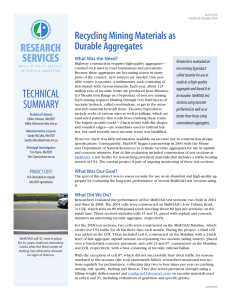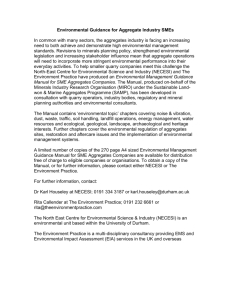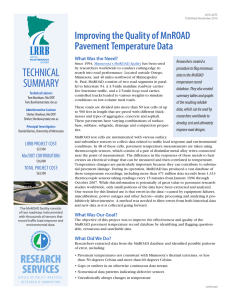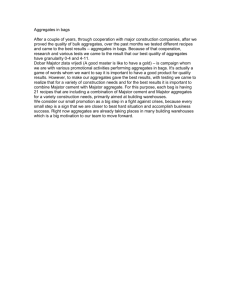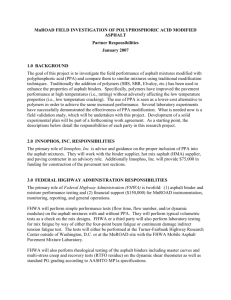Use of Taconite Aggregates in Pavement Applications June 2010
advertisement
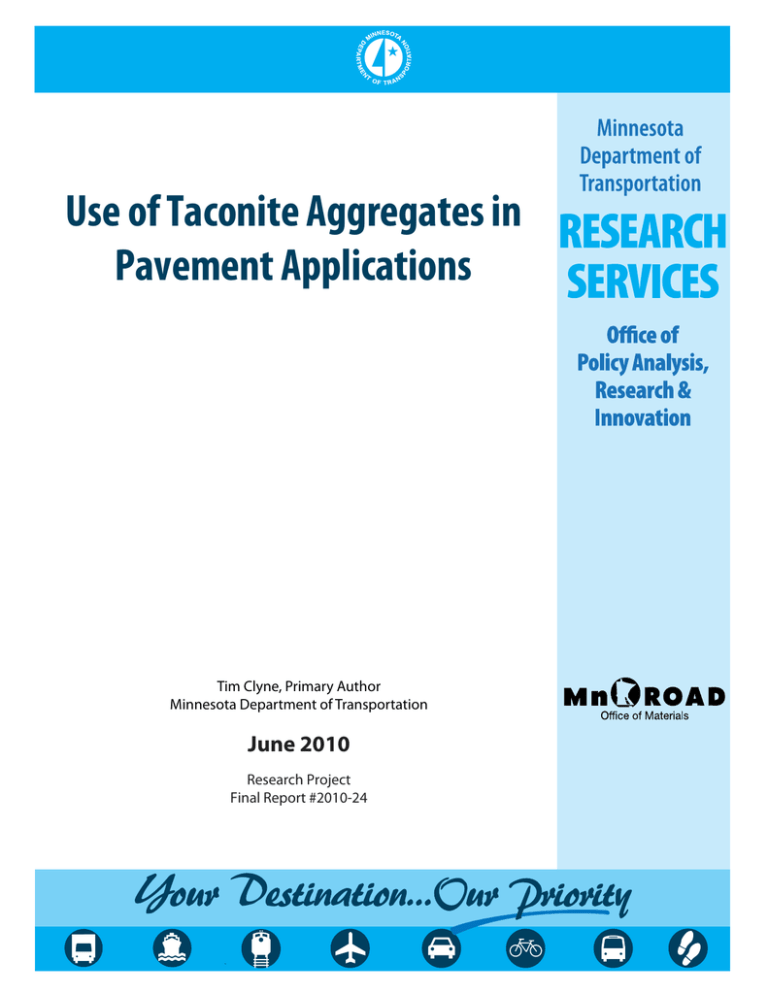
Use of Taconite Aggregates in Pavement Applications Tim Clyne, Primary Author Minnesota Department of Transportation June 2010 Research Project Final Report #2010-24 Technical Report Documentation Page 1. Report No. 2. 3. Recipients Accession No. MN/RC – 2010-24 4. Title and Subtitle 5. Report Date USE OF TACONITE AGGREGATES IN PAVEMENT APPLICATIONS June 2010 6. 7. Author(s) 8. Performing Organization Report No. Timothy R. Clyne, Eddie N. Johnson, and Benjamin J. Worel 9. Performing Organization Name and Address 10. Project/Task/Work Unit No. Minnesota Department of Transportation Office of Materials and Road Research 1400 Gervais Ave. Maplewood, MN 55109 11. Contract (C) or Grant (G) No. 12. Sponsoring Organization Name and Address 13. Type of Report and Period Covered Minnesota Department of Transportation Research Services Section 395 John Ireland Boulevard Mail Stop 330 St. Paul, Minnesota 55155 Final Report (2005-2009) 14. Sponsoring Agency Code 15. Supplementary Notes http://www.lrrb.org/pdf/201024.pdf 16. Abstract (Limit: 200 words) The construction and maintenance of highways creates a demand for high quality paving aggregates, which are becoming scarce in many parts of the country. Taconite industry waste rock and tailings are a potential new source of virgin aggregates. Currently there is limited information available for implementing these products in construction specifications. The goal of this project was to assess available taconite aggregate resources that could supply a high quality, low cost aggregate for roadway use, especially in areas where aggregates are becoming scarce. This report summarized the work completed under a government-academia-industry partnership that investigated the use of taconite aggregates for pavement applications. The following results were learned from this study: • Taconite aggregates can be used successfully to construct high quality aggregate base, asphalt, and concrete pavement layers. • The test sections constructed at MnROAD have performed as well as or better than those built using conventional aggregates. • A demonstration project was successfully completed in which microwave technology was used to patch a pothole on a local county road, and that pothole patch performed well over time. • Several laboratory tests performed on taconite aggregates or on asphalt mixtures consisting of taconite aggregates have shown very good performance. 17. Document Analysis/Descriptors 18.Availability Statement Taconite, Mesabi Hard Rock, Hot Mix Asphalt, Portland Cement Concrete, Aggregate No restrictions. Document available from: National Technical Information Services, Springfield, Virginia 22161 19. Security Class (this report) 20. Security Class (this page) Unclassified Unclassified 21. No. of Pages 21 22. Price USE OF TACONITE AGGREGATES IN PAVEMENT APPLICATIONS Final Report Timothy R. Clyne Eddie N. Johnson Benjamin J. Worel Minnesota Department of Transportation Office of Materials and Road Research 1400 Gervais Ave. Maplewood, MN 55109 June 2010 This report represents the results of research conducted by the authors and does not necessarily represent the views or policy of the Minnesota Department of Transportation. This report does not contain a standard or specified technique. Acknowledgements The authors would like to thank Larry Zanko, David Hopstock, and Don Fosnacht at the Natural Resources Research Institute at the University of Minnesota – Duluth for their oversight during this project as well as project funding. The authors would also like to thank Dave Linell, Jim McGraw, MnROAD staff, and the Metro Bituminous Lab staff at the Minnesota Department of Transportation. Finally, the authors are appreciative of Mihai Marasteanu and Mugur Turos at the University of Minnesota Department of Civil Engineering for additional laboratory testing on asphalt mixtures. 1 Introduction Background The construction and maintenance of highway infrastructure creates a demand for high quality paving aggregates, which are becoming scarce in many parts of the country. Taconite industry waste rock and tailings are a potential new source of virgin paving aggregates. Currently there is limited information available for implementing these products in construction design specifications. In 2004 the Minnesota Department of Transportation (Mn/DOT) began a partnership with the Minnesota Department of Natural Resources in order to evaluate taconite aggregates for use in asphalt and concrete mixtures. Part of this evaluation included construction of two test sections on the MnROAD Low Volume Road (LVR). A follow-up project with the Natural Resources Research Institute at the University of Minnesota – Duluth included continued monitoring of these LVR test cells, support for new construction using taconite aggregates, and other maintenance treatment trials. This current partnership uses federal funds from the Economic Development Administration of the U.S. Department of Commerce for research on Iron Range aggregate materials in various transportation applications. The goal of this project is to assess available taconite aggregate resources that could supply an abundant, high quality, low cost aggregate for roadway use, especially in areas where aggregates are becoming scarce. The main issues surrounding this coordinated research effort involve both engineering/ material properties and economics/logistics of transportation. Project Tasks The assigned tasks in conducting this research project along with a short description of each task are as follows: A. MnROAD Performance Monitoring for Existing Taconite Test Cells ⇒ Performance monitoring (distress mapping, rutting, faulting, friction, ride, testing, reports) will be completed for the two test cells constructed in 2004 (HMA Cell 31 and PCC Cell 54) and any completed projects in the future. B. MnROAD Future Test Cell Construction Support for 2008 ⇒ MnROAD was reconstructed in 2008, and designs were being considered when this research contract was signed. The taconite aggregates were being considered for three possible test sections of the Mainline, two of which were actually built. C. Taconite Use in Maintenance Treatments ⇒ This task was removed from the project and the funding transferred to Task E. MnROAD did not have available test sections for this type of research. D. Mn/DOT Taconite Demonstration Projects ⇒ NRRI noted that they have another funding source to help seed other state projects to demonstrate the use of taconite materials. This task was removed from the project and the funding transferred to Task B. E. Pothole Taconite Patch Material Study ⇒ MnROAD and the surrounding local road network is an excellent location to study patching material using taconite materials. F. Laboratory Testing of Taconite Materials 2 ⇒ Laboratory tests will be performed to establish that the taconite materials will be used in the most appropriate manner for long lasting roadways. Mn/DOT has the laboratory space and expertise to do the required material testing. 3 MnROAD Test Section Construction Several test cells have been constructed at MnROAD over the last five years using taconite aggregates. These were some of the first pavements built using taconite outside of Northeastern Minnesota. The goal of test cell construction has been to demonstrate the use of taconite as a viable construction material and to monitor the performance of in-service pavements built with those materials. Table 1 shows a summary of each MnROAD cell that was constructed with taconite aggregates, and the sections below describe each test cell in more detail. Table 1. MnROAD Test Cells with Taconite Aggregates Cell Year Taconite Component 31 2004 Low traffic volume Superpave asphalt mixture 54 2004 Concrete pavement mixture 6 2008 High traffic, thin asphalt mixture using two taconite tailing sources 23 2008 Railroad ballast base material 87 2008 Railroad ballast base material 2004 Test Cell Construction Two test sections were built on the MnROAD Low Volume Road in 2004. These projects came about through a partnership between the Minnesota Department of Natural Resources (DNR), the Local Road Research Board (LRRB), the Minnesota Department of Transportation (Mn/DOT), and Federal Highway Administration (FHWA). Traffic loading is applied to both cells via the standard MnROAD 80,000 lb truck, which travels approximately 80 laps per day each weekday on the inside lane. The outside lane is reserved to study environmental effects on pavement performance, so no truck traffic has been allowed on that lane since 2007. Cell 31 Cell 31 was reconstructed with hot mix asphalt (HMA) that contained 80% Mesabi Select Hard Rock aggregate. Three different taconite products were used: two sizes of coarse aggregate materials and a manufactured washed sand (as well as a natural sand). It marked the first asphalt mix of its kind that utilized taconite aggregate as both the coarse and fine aggregates of the asphalt mix in the Twin Cities area. The purpose of this test cell was to demonstrate to the paving industry that taconite can be used to produce an asphalt mixture meeting Mn/DOT specifications. It also demonstrated that the mixture can be placed like other HMA mixtures, and through instrumentation installed at the MnROAD site to measure the pavement response to environmental and traffic loading, its performance can be documented and quantified (1). Cell 31 measures 500 ft long by 24 ft wide. Since the cell is located on the Low Volume Road (LVR), the design 20-year ESALs were 110,000, which resulted in a 4” mat thickness over 16” of aggregate base in accordance to MnPAVE software. The asphalt mix design was designated traffic level 2, primarily because the taconite aggregates could not meet the flat & 4 elongated requirement for higher level mixes. A polymer modified PG 64-34 binder was used at an asphalt content of 6.4%. The taconite aggregate in the HMA accounted for a high unit weight (approximately 160 pounds per cubic foot), which is about 10% heavier than the typical HMA mix in Minnesota. Because of its increased density and angularity, heavy rollers were specified for its compaction in the field. Asphalt paving took place in August 2004. The existing asphalt shoulders, with several working thermal cracks, were left in place. Commercial Asphalt provided the HMA, and Frattalone performed the asphalt paving. Cell 54 Cell 54 was constructed on the Low Volume Road to study properties of Mesabi Select as an aggregate in concrete. This mineral aggregate was obtained from overburdens on the iron ore ledges in northern Minnesota. This is also believed to be the first test section constructed to study the suitability of Mesabi Select in concrete (2). Cell 54 was constructed in October 2004. It is made up of 8” of concrete over variable depths of Class 5 aggregate base and approximately 3” of compacted in-situ fill. This project constructed a 192-ft jointed-plain-dowelled concrete pavement comprising two lanes of 12- by 15-ft slabs paved by a slip-form paver. The longitudinal joints were tied and unsealed. A number of sensors were installed by researchers to collect performance data including embedded dynamic strain gauges, vibrating wires, moisture sensors, and thermocouples. In the finishing process, a 30” strip of untextured pavement was created by indenting the width of the Astroturf drag to study various surface characteristics. The contractor applied alphamethyl-styrene curing compound to the finished surface, similar to other typical concrete paving projects. The research objectives for the Cell 54 initiative were: • To construct a concrete pavement with taconite aggregate and investigate the material properties of the product placed. • To investigate the rheological and mechanical properties of taconite aggregate concrete. • To study long-term performance of a concrete pavement on a low volume road built out of taconite aggregate. • To determine the susceptibility of the aggregate to adverse effects in the presence of conventional admixtures. • To investigate the adaptation of taconite aggregate to traditional mix design variables, such as low water cement ratio, well-graded aggregates, and aggregate absorption. • To construct an un-textured strip on the finished surface for a continuation of Mn/DOT’s study of the effect of pavement texture and joints on ride quality. • To provide a framework for the structural use of taconite aggregate in concrete. 2008 Test Section Construction Three test sections were constructed in 2008 using taconite aggregates as part of Mn/DOT’s 2008 MnROAD Phase II initiative. Funding for these studies was provided by the Natural Resources Research Institute (NRRI) at the University of Minnesota – Duluth. Two cells were constructed on the Mainline, which carries live Interstate 94 traffic, and a third was added during the project on the Low Volume Road (3). The cells are described in detail the sections below. 5 The taconite aggregate materials used in this study were delivered to MnROAD via specialized RailMate trailers. These trailers were loaded with aggregates from the taconite mines in northern Minnesota, hauled to Minneapolis via freight train, and then pulled by semi tractor to MnROAD where they were unloaded. This method of shipping demonstrated a viable option to haul taconite aggregates long distances in the future for road construction projects where local aggregates may become scarce. Figure 1. RailMate Trailers Hauling Taconite Aggregates to MnROAD Cell 6 Cell 6 was constructed on the Mainline to investigate the performance of a thin layer of fine aggregate asphalt mixture. It consisted of a 2” HMA overlay of a new 5” concrete pavement. This cell also supported a pooled fund study of composite pavements, and it was split into subcells 106 and 206 (dowelled and undowelled concrete, respectively). The HMA was a 4.75 mm Superpave mixture comprised of two sources of fine taconite tailings along with a local granite manufactured sand. The National Center for Asphalt Technology (NCAT) in Auburn, Alabama designed the mixture for a laboratory study, and this was a chance to validate that design with a field test section. Fine mixtures such as this are attractive for their potential for surface course and thin lift applications. The taconite HMA overlay will be evaluated for its surface characteristics (noise, ride, texture, and friction) as well as durability and resistance to reflective cracking. Hardrives paved the 4.75 mm asphalt mixture in a single lift in late October 2008. The HMA was only able to achieve about 90% to 91% density in the field, which was typical of other 4.75 mm mixtures observed by NCAT (4). The mixture proved tough and durable, resisting damage by turning truck movements while paving the shoulders later the same day. Researchers from NCAT were on hand to observe the paving and perform early testing, and many samples of HMA were taken for several research groups to conduct laboratory performance testing. 6 Cell 23 Cell 23 was constructed on the Mainline to investigate the performance of taconite railroad ballast as an aggregate base material. MnROAD has had previous experience with large stone base materials, as they provide a strong, stable foundation for pavements. The ballast was approximately 2” in size with flat shapes and rounded edges. Since this is not a typical road base material, it required different construction techniques than normal (the rounded particle shapes prevented the aggregates from “interlocking” like a typical base material). The ballast was pushed into place by a dozer and rolled vigorously to “seat” the aggregate (it could not be compacted per se). Researchers later discovered that this compactive effort actually fractured many of the particles in the lower part of the layer and accounted for dynamic grading from top to bottom in the base layer. Researchers are concerned that the ballast will continue to fracture under traffic loading, which will in turn allow the base material to shift and cause moderate rutting. The ballast lies directly over a geotextile to separate the particles from 19” of sandy aggregates underneath. Five inches of asphalt provide the surface wearing course over the taconite base material. The HMA quantities on the bottom lift overran by about 30% due to loss into the voids in the ballast, but this is not expected to have a significant impact on performance. Figure 2. Dynamic Grading of the Taconite Ballast Base Material Cell 87 This cell was not expected to use taconite materials at the beginning of the project. Cell 87 is a control section on the Low Volume Road for porous asphalt and pervious concrete pavements. The aggregate base material in these cells was CA-15, an open graded, river run gravel. While good for draining water through the pavement system, this material was not stable enough to hold construction traffic. The top 4” of the design base structure was replaced with railroad ballast, which would provided the needed stability for construction while still allowing the base to be permeable. A small stockpile of taconite railroad ballast material was left over after construction of Cell 23, so that was used to stabilize Cell 87. There was not enough taconite ballast for the other pervious pavement sections, so granite material was hauled in from a local quarry. It is not known if the ballast in Cell 87 fractured the same way as it did in Cell 23 during construction. 7 MnROAD Test Section Performance Monitoring Introduction One of the advantages of constructing test sections at MnROAD is that researchers have a safe environment to monitor the pavements. The Mainline traffic is typically diverted to the old westbound I-94 section for three days each month, and the Low Volume Road traffic is limited to the MnROAD standard 80,000 lb truck. The Mainline cells (6 and 23) have been in place for 1 year and have seen approximately 1 million ESALs. The Low Volume Road cells (31 and 54) have been in place for about 5 years and have seen roughly 75,000 ESALs. MnROAD staff and other researchers monitor each of the test sections on a regular schedule, typically collecting a particular piece of data 2-4 times per year. The data presented below was from the most recent fall 2009 data collection period. Distress The concrete test section on the LVR (Cell 54) has shown minimal distress after five years of traffic. Two small longitudinal cracks and one transverse crack appeared in the inside lane in spring 2009. It is possible that this distress has come from testing heavy farm equipment on this portion of the LVR. Some of the vehicles tested have been 7500+ gallon tankers with a gross vehicle weight of over 160,000 lbs. Otherwise no faulting or other distress has been present in Cell 54. Cell 31 has two transverse cracks that appeared after the third winter. Thermal cracks were not expected in this pavement, as the soft binder was expected to resist thermal cracking. However, the wide working cracks in the existing shoulder extended through the pavement section. Otherwise no distress is present. Cell 6 has not resisted cracking nearly as well as expected. Three transverse cracks have appeared after less than one year, but they are likely reflective cracks over midpanel cracks in the underlying concrete. Seven longitudinal cracks appeared in fall 2009; it is unclear if the cracks originated in the HMA layer or in the concrete underneath. Cores will be taken in spring 2010 to determine the extent of cracking. Finally, the taconite HMA has exhibited reflective cracking at about 75% of the concrete joints. Researchers anticipated better reflective cracking performance out of this mixture based on laboratory testing, but in reality very few mixtures would be capable of resisting reflective cracking in this situation. Cell 23 has shown slightly more rutting than other similar Mainline cells, but it is far from the point of needing rehabilitation. There is no other noticeable distress on Cell 23. 8 Figure 3. Typical Cracking Pattern on Cell 6 (Left) and Cell 31 (Right) Rutting Rutting data at MnROAD is collected with an automated laser profile system (ALPS). This machine consists of a laser mounted on an aluminum beam, which measures the elevation at approximately every 1” across each lane. A software program was written to calculate the rut depth from each measurement (5). The rut depths for each MnROAD cell using taconite aggregates are shown in Figure 4 below. All of the cells are well below an average rut depth of ½”, which is the trigger for rehabilitation in Minnesota. Fall 2009 Rutting Data 0.50 0.45 1/2" rutting = trigger for rehab Average Rut Depth, Inches 0.40 0.35 0.30 0.25 0.20 0.15 0.10 0.05 0.00 Cell 6 ‐ Driving Cell 6 ‐ Passing Cell 23 ‐ Driving Cell 23 ‐ Passing Cell 31 ‐ Inside Cell 31 ‐ Outside Figure 4. MnROAD Rutting Performance 9 Cell 87 ‐ Inside Cell 87 ‐ Outside Ride Ride quality at MnROAD is typically collected twice per year by the Mn/DOT Pavement Management Unit using the Pathways van. The data is shown in Figure 5. The white bars indicate the International Roughness Index (m/km), which is a measure of the amount of “bumpiness” in the ride. This data is then put into an equation that calculates the Ride Quality Index, indicated by the colored bars in the figure. All of the MnROAD taconite cells have an RQI of around 3.0, which is the divider between “good” and “fair” ride quality. These numbers may be slightly lower than expected, but they can likely be attributed to the cracking in each cell. Fall 2009 Pathways Data RQI 3.4 IRI 3.2 "Good" 3.0 "Fair" 2.8 2.6 2.4 Pavement Index 2.2 2.0 1.8 1.6 1.4 1.2 1.0 0.8 0.6 0.4 0.2 0.0 Cell 6 Driving Cell 6 Passing Cell 31 Inside Cell 31 Outside Cell 54 Inside Cell 54 Outside Figure 5. MnROAD Ride Quality Data Faulting Faulting is measured at MnROAD using a handheld Georgia Faultmeter. It measures the amount of dropoff from one concrete slab to the next. Neither Cell 6 nor Cell 54 has shown any measureable faulting to date. The dowel bars are providing adequate load transfer to this point. 10 FWD The falling weight deflectometer (FWD) is a device used at MnROAD to test the strength of pavement structures, among other uses. It drops a known load on a circular load plate and measures the deflection at specific distances away from the plate. By looking at the deflection basins, one is able to determine the strength of various pavements and compare one to another. Figure 6 below shows a comparison of FWD data between Cell 23 (taconite railroad ballast) and Cell 19 (Class 5 aggregate base). The only difference between these two cells is the aggregate base material – all other materials and thicknesses are the same. This plot shows the deflection directly under the load plate, and it shows several measurements over the course of a year. The deflections from Cell 23 are consistently significantly lower than those from Cell 19, indicating that the taconite ballast is significantly (25% or more) stronger than the traditional aggregate base. The seasonal variation of different pavement materials is evident in Figure 6 as well. Each cell exhibits high deflections in the spring while the ground is wet, then showing lower deflections in summer and fall as the base and subgrade dry out. Driving Lane ‐ Outer Wheel Path 600 Deflection Under Load Plate, microns 500 400 300 200 Cell 23 (taconite ballast) 100 Cell 19 (class 5) 12/13/09 11/23/09 11/3/09 10/14/09 9/24/09 9/4/09 8/15/09 7/26/09 7/6/09 6/16/09 5/27/09 0 Date Figure 6. FWD Data Comparing Taconite and Traditional Aggregate Base Materials 11 Friction Mn/DOT friction data is typically collected twice per year using a Dynatest 1295 Pavement Friction Tester according to ASTM-E274, "Specification for Skid Resistance Using a Full Scale Tire." A pickup truck pulls a specialized trailer that employs either a smooth or ribbed tire, which locks its wheels while calculating the forces necessary to do so. Figure 7 shows the data collected in the driving or inside lane of each taconite cell using the ribbed tire. A friction number above 40 is considered “good” friction, and a FN above 50 is sometimes called “very good.” All three cells with taconite aggregates used in the pavement surface have shown very good friction over time. The concrete cell (54) has been relatively steady over time, while the asphalt LVR cell (31) has been decreasing slightly over time. Both behaviors are expected. The initial friction measurement on Cell 6 was rather low, but this was due to a large amount of dirt and other construction debris on the road during testing. Subsequent measurements have been quite good. Ribbed Tire 80 70 Friction Number 60 50 "Good" Friction 40 Debris on road during testing 30 20 Cell 6 Cell 31 10 Cell 54 0 8/1/2004 8/1/2005 8/1/2006 8/1/2007 Date 8/1/2008 Figure 7. MnROAD Ribbed Tire Friction Data 12 8/1/2009 Laboratory Testing of Taconite Materials Summary Mn/DOT has been involved in several projects investigating the engineering properties of taconite aggregates over the years. One such study was completed in 2006. It concluded that taconite aggregates, when properly crushed and sized, can be used to produce high quality Superpave, stone matrix asphalt, and fine asphalt mixtures (6). Other projects involving laboratory tests at Mn/DOT and the University of Minnesota have had their results published elsewhere. A new project entitled, “Performance of Taconite Aggregates in Thin Lift HMA” has recently been initiated, with funding provided by the Federal Highway Administration. The goal of this project is to further investigate the environmental and pavement performance of thin lift HMA pavements. This project may utilize several of the same aggregates that have been used at MnROAD in the past and are stored in stockpiles at the MnROAD facility. Within the current study supported by NRRI, one objective was to perform laboratory tests on taconite aggregates and on pavements made out of taconite aggregates to establish how these materials will be used in the most appropriate manner for long-lasting roadways. A myriad of tests were performed over the past year by Mn/DOT, the University of Minnesota, and several other research partners. The results of these tests will not be duplicated in this report; instead the reader is referred to the Task F report for this project (7). In summary, three different aggregate materials were tested at the Mn/DOT Maplewood Lab and other locations. The aggregates were all used in test cells during the MnROAD 2008 construction season. The specific aggregates tested were: • Railroad Ballast (aggregate base in Cell 23) • Ispat Tailings (HMA aggregate in Cell 6) • MinTac Tailings (HMA aggregate in Cell 6) The ballast material was run though a few basic laboratory test procedures including gradation and specific gravity. The two tailings sources were run through these tests as well as additional tests relevant to asphalt mixtures including fine aggregate angularity and percent crushed. These tests were run on the individual aggregates and on the combination of three aggregates used in the HMA, both during the mix design stage and extracted from actual loose mix sampled from MnROAD. The asphalt mixture from Cell 6 underwent a series of tests for both construction quality assurance and advanced performance. In general, the asphalt mixture composed of taconite aggregates performed as well as or better than asphalt mixtures composed of conventional aggregates. The specific aggregates used at MnROAD in 2008 have proven to be tough, durable materials. 13 Table 2. Summary of Laboratory Tests Performed on Taconite Materials Material Laboratory Test Railroad Ballast Gradation, Gsb MinTac Tailings Gradation, Gsb, FAA, % Crushed Ispat Tailings Mn/DOT Gradation, Gsb, FAA, % Crushed HMA Aggregate Blend HMA Mixture Gradation, Gsb, FAA, % Crushed Mn/DOT Volumetrics, APA Rutting, TSR Stripping*, Dynamic Modulus* University of Minnesota Semicircular Bend, Indirect Tensile Creep & Strength, BBR Creep Ohio University ABCD Mix Test* Texas Transportation Institute Texas Overlay Tester, Hamburg Wheel Tracking, Seismic Modulus University of California at Davis Superpave Shear Tester*, Beam Fatigue* National Center for Asphalt Technology Porosity*, Rutting* * Still awaiting test results 14 Pothole Patch Material Study Spring 2009 Pothole Repairs A field experiment was performed in March 2009 to provide information on the practicality and usefulness of performing patching with microwave technology. Researchers at the University of Minnesota – Duluth have been investigating this microwave technology in the laboratory for some time, so this was a chance to perform a live field validation. The location of the demonstration was at the intersection of two bituminous roads in the town of Otsego, MN near the MnROAD facility. The pothole had developed at a transverse crack, and was in the right wheel path of the westbound lane of 70th St. The loss of pavement material was primarily on the departure side of the pothole. Local traffic included multiple truck passes due to a nearby concrete plant. The air temperature during patching operations was approximately 33ºF. The area had received a light dusting of snow overnight, and the pavement was still slightly damp as work commenced. Researchers used 100% recycled asphalt pavement (RAP) as the patching material – no taconite aggregates were present in the patch. This demonstration will serve as a baseline for comparison in potential future trials. Maintenance workers used a 915 MHz microwave source to first heat up the existing pothole and then to heat up the RAP material as it was added to the pothole. Maximum temperatures of the patch material reached about 240ºF, which was hot enough to activate the binder in the RAP and allow it to adhere to the sides of the pothole. The entire process of filling one pothole with this microwave technology took about 50 minutes (8, 9). Figure 8. Microwave Pothole Patch Repair 15 Pothole Patch Performance The condition of the pothole patch was monitored several times over the course of the year. Table 3 shows a summary of condition at each time period. Table 3. Performance Summary of Microwave Pothole Patch Date Days of Service Condition April 4, 2009 15 Patch had developed material loss along 5” of the approach side and at one corner. Amount of missing material is < 10 % of total patch area. April 24, 2009 35 Increasing regions of material loss were visible. An estimated 10 % of patch material was missing. July 21, 2009 123 Material loss had increased along the sides of the patch to a depth of 2”. Amount of missing material is > 10 % of the total patch area. August 2009 ~ 140 Patch was removed when Otsego maintenance crews performed extensive patching and rehabilitation along 70th St. Summary and Future Work The pothole patch that was installed for this project seemed to perform about the same, if not slightly better, than traditional pothole patches. Before this technology is widely accepted, however, the process needs to be made more efficient. With the amount of potholes that appear each spring in Minnesota, maintenance workers will not want to spend upwards of 50 minutes filling each pothole. They will need a process that is quick and efficient so that they can cover a large area in a short amount of time. Development work is ongoing at NRRI to develop better methods of pothole patching. The use of taconite aggregates is being thoroughly investigated, with the idea that the magnetic properties of the rock will absorb microwave energy more readily to make the process more efficient. Other avenues are also being pursued including particular patching materials for asphalt and concrete pavements, respectively, using epoxy and other non-bituminous binding agents. 16 Summary and Future Work This report summarized the work completed under a Mn/DOT – NRRI partnership that investigated the use of taconite aggregates for pavement applications. The following results were learned from this study: • Taconite aggregates can be used successfully to construct high quality aggregate base, asphalt, and concrete pavement layers. o Construction specifications have been written around the taconite materials used at MnROAD, and with proper processing techniques taconite aggregates can fit within existing Mn/DOT specifications. • The test sections constructed at MnROAD have performed as well as or better than those built using conventional aggregates. o Skid resistance in particular has been exceptional in the taconite cells, and other parameters such as rutting, cracking, and ride quality have been satisfactory. • A demonstration project was successfully completed in which microwave technology was used to patch a pothole, and that pothole patch performed well over time. o The patching operation will need to be made more efficient (i.e., quicker) for this process to gain widespread use. • Several laboratory tests were performed on taconite aggregates or on asphalt mixtures consisting of taconite aggregates. o Material properties of the taconite aggregates and mixtures have by and large been as good as or better than those of traditional aggregates. Further research will continue under a contract for Federal Highway Administration, in which we will develop laboratory mix designs for thin lift HMA applications. Some of these mixtures may include stone matrix asphalt (SMA), 4.75 mm Superpave, and conventional Superpave mixes. We will continue to monitor the performance of the existing test sections at MnROAD incorporating taconite aggregates. It is expected that taconite will prove to be a strong, durable material for the paving industry for many years to come. 17 References 1. W. J. Zerfas, B. Worel, and R. Mulvaney, 2004 MnROAD Mesabi Select Hot Mix Asphalt (LRRB Inv. 819) – Cell-31 Low Volume Road Construction Report, Minnesota Department of Transportation, March 2005. (http://www.mrr.dot.state.mn.us/research/pdf/2005MRRDOC003.pdf) 2. B. Izevbekhai and R. Rohne, MnROAD Cell 54: Cell Constructed With Mesabi-Select (Taconite-Overburden) Aggregate; Construction and Early Performance, Minnesota Department of Transportation Final Report MN/RC 2008-18, June 2008. (http://www.mrr.dot.state.mn.us/research/pdf/200818.pdf) 3. A. Johnson, T. R. Clyne, and B. J. Worel, 2008 MnROAD Phase II Construction Report, Minnesota Department of Transportation Final Report MN/RC 2009-22, June 2009. (http://www.mrr.dot.state.mn.us/research/pdf/200922.pdf) 4. R. C. West, M. A. Heitzman, D. M. Rausch, and G. Julian, Laboratory Refinement and Field Validation of 4.75 mm Superpave Designed Asphalt Mixtures, National Center for Asphalt Technology, Draft Final Report, August 2009. 5. B. Worel, B. Chadbourn, and R. Strommen, “MnROAD Automated Laser Profile System ‘ALPS’,” Proceedings CD-ROM from 2nd International Conference on Accelerated Pavement Testing, Minneapolis, MN, September 26-29, 2004. 6. R. Olson, J. Garrity, L. Zanko, D. Martin, B. Worel, R. Betts, D. Linell, C. Cochran, and E. Johnson, Investigation of the Design of Asphalt Paving Mixtures Using Minnesota Taconite Rock, Minnesota Department of Transportation Final Report, April 2006. (http://www.mrr.dot.state.mn.us/research/pdf/2006MRRDOC001.pdf) 7. T. Clyne, E. Johnson, and B. Worel, Project No. MPR-6(023): Use of Taconite Aggregates in Pavement Applications – Task F Report: Laboratory Testing of Taconite Materials, Minnesota Department of Transportation, July 2009. 8. E. Johnson, Pothole Patch Trial with Asphalt Pavement Millings and 915 MHz Microwave, ThermaCAM Thermal Imaging Report, Minnesota Department of Transportation, March 2009. 9. E. Johnson, Installation and Performance Monitoring of a Pothole Patched Using Asphalt Pavement Millings and a 915 MHz Microwave, Minnesota Department of Transportation, October 2009. 18
